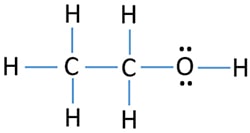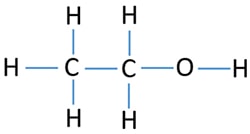Ethanol (CH3CH2OH) Lewis Structure
Ethanol (CH3CH2OH) contains two carbon atoms, six hydrogen atoms and one oxygen atom. Two carbon atoms have joint with a single bond and oxygen atom has made bonds with carbon and hydrogen atoms. There are two lone pairs on oxygen atom.
CH3CH2OH lewis structure

In the lewis structure of ethanol, all bonds between atoms are single bonds. One hydrogen atom has joint with oxygen atom and that oxygen atom is joint with one carbon atom. There are two lone pairs in the valence shell of oxygen atom.
Steps of drawing lewis structure of CH3CH2OH
When we draw a lewis structure, there are several guidelines to follow. Number of steps can be changed according the complexity of the molecule or ion. However those all steps are mentioned and explained in detail in this tutorial for your knowledge.
- Find total number of electrons of the valance shells of carbon, hydrogen and oxygen atoms
- Determine total electrons pairs existing as lone pairs and bonds
- Deciding center atom selection
- Mark lone pairs on atoms
- Mark charges on atoms if there are charges.
- Check the stability and minimize charges on atoms by converting lone pairs to bonds to obtain best lewis structure.
Total number of electrons of the valance shells of CH3CH2OH
There are three elements in ethanol molecule; carbon, hydrogen and oxygen. Hydrogen is a group IA element in the periodic table and only has one electron in its last shell (valence shell).Carbon is a group IVA element in the periodic table and has four electrons in its last shell (valence shell). Also, Oxygen is a group VIIA element in the periodic table and contains six electrons in its last shell. Now, we know how many electrons are there in valence shells of hydrogen, carbon and oxygen atoms.
- valence electrons given by hydrogen atom = 1 * 6 = 6
- valence electrons given by carbon atom = 4 * 2 = 8
- valence electrons given by chlorine atoms = 6 * 1 = 6
- Total valence electrons = 6 + 8 + 6 = 20
Total valence electrons pairs
Total valance electrons pairs = σ bonds + π bonds + lone pairs at valence shells
Total electron pairs are determined by dividing the number total valence electrons by two. For, ethanol, total pairs of electrons are ten in their valence shells.
Center atom of ethanol
There are several guidelines to identify the center atom of a molecule and there are explained in detail for ethanol molecule. Because, there are three kinds of elements and nine atoms, selection of center atom can be little difficult than doing the same for a simple molecule.
Hydrogen atom cannot be a center atom because hydrogen can only keep two electrons in last shell.
Because, carbon can show higher valance than oxygen, carbon has the higher chance to be the center atom in ethanol. Also, carbon is more electropositive than oxygen, it again proves, carbon should be the center atom in ethanol.
However, because ethanol contains nine atoms, both carbon atoms are locates as center atoms.

Lone pairs on atoms
After determining the center atom and sketch of ethanol, we can start to mark lone pairs on atoms. Remember that, there are total of ten electron pairs.
- There are already eight bonds in the drawn skeletal. So, now only two electron pairs are remaining to mark as lone pairs.
- Usually, those two remaining electron pairs should be started to mark on outside atoms.
- But, we cannot mark more lone pairs on hydrogen atoms because hydrogen atoms already have two electrons in their valence shells. Therefore, we can mark those two remaining electrons pairs on oxygen atom.
- Then, there will be no more lone pairs to mark on carbon atom.

Mark charges on atoms in ethanol
There are no charges on atoms in above drawn structure. Then, we can go to the next step of reduce of charges if there are any.
Check the stability and minimize charges on atoms by converting lone pairs to bonds
Because three are no charges on atoms in ethanol molecule, we do not need to do the step of reducing charges on atoms by converting lone pairs to bonds.
That means, we have already obtained a very stable structure for ethanol molecule and we can consider it as the lewis structure of ethanol.
Have Questions?